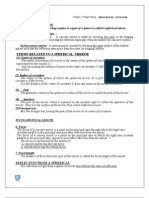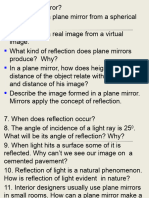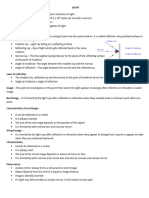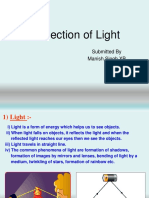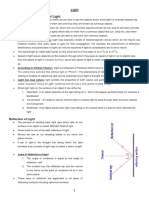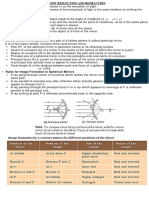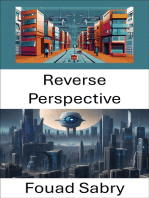Reflection of Light
Reflection of Light
Uploaded by
PHOENIXCopyright:
Available Formats
Reflection of Light
Reflection of Light
Uploaded by
PHOENIXOriginal Title
Copyright
Available Formats
Share this document
Did you find this document useful?
Is this content inappropriate?
Copyright:
Available Formats
Reflection of Light
Reflection of Light
Uploaded by
PHOENIXCopyright:
Available Formats
REFLECTION OF LIGHT
The return of light into the same
medium after striking a surface is
called reflection.
Kinds of reflection: There are the following two kinds of reflection:
(i) Regular reflection, and
(ii) Irregular reflection.
(i) Regular reflection: Regular reflection occurs when a beam of light falls on a
smooth and Regular
reflection polished
surface, such as a plane
mirror.
(ii) Irregular reflection:
Irregular reflection
occurs when a beam of
light falls on a rough or
ordinary surface such as
the wall of a room, the
page of a book or any other object. It is the diffused light obtained by
reflection from various uneven surfaces which enables us to see the objects
around us.
SOME TERMS RELATED WITH REFLECTION
(i) Incident ray: The light ray striking a reflecting surface is called the incident
ray.
(ii) Point of incidence: The point at which the incident ray strikes the
reflecting surface, is called the point of incidence.
(iii) Reflected ray: The light ray
obtained after reflection from the
surface, in the same medium in which
the incident ray is travelling, is called
the reflected ray.
(iv) Normal: The perpendicular drawn
to the surface at the point of incidence,
is called the normal.
(v) Angle of incidence: The angle which the incident ray makes with the
normal at the point of incidence, is called the angle of incidence. It is denoted
by the letter i.
(vi) Angle of reflection: The angle which the reflected ray makes with the
normal at the point of incidence, is called the angle of reflection. It is denoted
by the letter r.
(vii) Plane of incidence: The plane containing the incident ray and the normal,
is called the plane of incidence.
(viii) Plane of reflection: The plane containing the reflected ray and the
normal, is called the plane of reflection.
LAWS OF REFLECTION
(1) The angle of incidence i is equal to the angle of reflection r (i.e. ∠i = ∠r) .
(2) The incident ray, the reflected ray and the normal at the point of incidence,
lie in the same plane.
FORMATION OF IMAGE BY REFLECTION
From each point of an illuminated object, rays of light travel in all directions.
To find the position of image of an object formed by a mirror after reflection,
we need to consider at least two rays of light incident on the mirror from a
point of object.
Types of image: The image can be of two types:
(a) real image, and
(b) virtual image.
Real image
1. A real image is formed due to actual intersection of the reflected rays.
2. A real image can be obtained on a screen.
3. A real image is inverted with respect to the object.
Example: The image an of a distant object formed by a concave mirror.
Virtual image
1. A virtual image is formed when the reflected rays meet if they are produced
backwards.
2. A virtual image cannot be obtained on a screen.
3. A virtual image is erect with respect to the object.
Example: The image of object formed by a plane mirror or by a convex mirror.
POSITION OF IMAGE
The image I is as far behind the mirror as the
object O is in front of it. The image is situated on
the normal drawn from the object on the mirror
and it is as far behind the mirror as the object is
in front of it.
LATERAL INVERSION
The interchange of the left and right sides in
the image of an object in a plane mirror is
called lateral inversion.
CHARACTERISTICS OF THE IMAGE FORMED BY A PLANE MIRROR
The image formed by a plane
mirror has the following
characteristics :
(i) upright (or erect),
(ii) virtual,
(iii) of same size as the object,
and
(iv) laterally inverted.
The location of the image is given by the fact that, the image is situated at the
same perpendicular distance behind the mirror as the object is in front of it.
IMAGES FORMED IN TWO INCLINED MIRRORS
For an object kept in between two inclined plane mirrors, we get many images
of the object. This is because the light rays after reflection from one mirror
fall on the other mirror.
The object and the images formed by the two inclined mirrors lie on the
circumference of a circle whose centre lies at the point of intersection of the
two mirrors and radius is equal to the distance of object from the point of
intersection.
IMAGES FORMED IN A PAIR OF MIRRORS PLACED
PARALLEL TO EACH OTHER
For two mirror kept parallel to each other, an
infinite number of images are formed for an object
kept in between them.
IMAGES FORMED BY TWO MIRRORS PLACED
PERPENDICULAR TO EACH OTHER
For two mirrors kept perpendicular to each other, three
images are formed for an object kept in between them.
USES OF PLANE MIRROR
(1) The most common and wide use is as a looking glass
(2) In the optician's room to increase the effective length of the room.
(3) In the barber's shop for seeing the hair at the back of head. Here two
mirrors facing each he other are fixed on opposite walls at the front and back
of the viewer.
((4) In a periscope, two parallel plane mirrors each inclined at 45° with vertical
walls are placed facing each other.
(5) In a kaleidoscope, three plane mirrors inclined with each other at 60° are
used. If small coloured bangle pieces are kept between the mirrors, beautiful
hexagonal patterns are seen. On rotating the tube, the designs of patterns
change.
SPHERICAL MIRRORS
A reflecting surface which is a part of a sphere is
called a spherical mirror.
Types of Spherical Mirror:
(i) Concave mirror
A concave mirror is made by silvering the
outer surface of the piece of a hollow
sphere
(ii) Convex mirror
A convex mirror is made by silvering the
inner surface of the piece of a hollow
sphere such that the reflection takes
place from the outer surface.
BRIEF INTRODUCTION OF TERMS RELATED TO A SPHERICAL MIRROR
(1) Centre of curvature
The centre of curvature of a mirror is the centre of the sphere of which the
mirror is a part.
(2) Radius of curvature
The radius of sphere of which the spherical
mirror is a part, is called the radius of curvature
of the mirror.
(3) Pole
The geometric centre of the spherical surface of mirror is called the pole of
mirror.
(4) Aperture
The plane surface area of the mirror through which light rays enter and fall
on the mirror is called its aperture.
(5) Principal axis
It is the straight line joining the pole of the mirror to its centre of curvature.
FOCUS AND FOCAL LENGTH
The focus of a concave mirror is a
point on the principal axis through
which the light ray’s incident parallel
to the principal axis, pass after
reflection from the mirror.
The focus of a convex mirror is a
point on the principal axis from
which, the light ray’s incident
parallel to the principal axis, appear
to come, after reflection from the mirror.
CONVENIENT RAYS FOR THE CONSTRUCTION OF IMAGE BY RAY DIAGRAM
(1) A ray passing through the centre of curvature,
(2) A ray parallel to the principal axis,
(3) A ray passing through the focus,
(4) A ray incident at the pole.
(1) A ray passing through the centre of
curvature
A ray passing through (or directed
towards) the centre of curvature of a
spherical mirror, is reflected back along
its own path.
(2) A ray parallel to the principal
axis
A ray incident parallel to the
principal axis, after reflection from
a spherical mirror either passes or
appears to be coming from focus.
(3) A ray passing through the focus
A ray either incident from the focus
(or converging at the focus), after
reflection from a spherical mirror
becomes parallel to the principal axis.
(4) A ray incident at the pole
For a ray incident at the pole of a
spherical mirror, the reflected ray
is at an angle of reflection equal
to the angle of incidence with
principal axis as normal.
RAY DIAGRAMS FOR FORMATION OF IMAGES
IN A CONCAVE MIRROR
Case (i): When the object is at infinity
When the object is at infinity, the image is at
the focus F. It is (i) Real, (ii) Inverted and (iii)
Diminished to a point.
Case (ii) When the object is at a far distance
When object is at a far distance, image is in
the focal plane of the mirror. It is (i) Real, (ii)
Inverted, and (iii) Highly diminished.
Case (iii): When object is beyond the
centre of curvature
When object is beyond the centre of
curvature C, the image is between the
focus F and the centre of curvature C. It
is (i) Real, (ii) Inverted, and (iii)
Diminished.
Case (iv): When object is at the centre of
curvature C
When the object is at the centre of
curvature C, the image is also at the
centre of curvature C. It is (i) Real, (ii)
Inverted, and (iii) Size same as that of the
object.
Case (v): When object is between the
centre of curvature C and focus F
When the object is between the centre
of curvature C and the focus F. the
image is beyond the centre of
curvature C. It is (i) Real, (ii) Inverted,
and (iii) Magnified.
Case (vi); When object is at the focus F
When the object is at the focus F, the image is
at infinity. It is (i) Real, (ii) Inverted, and (iii)
Highly magnified.
Case (vii): When the object is between the
focus F and the pole P
When the object is between the focus F
and pole P, the image is behind the mirror.
It is (i) Virtual, (ii) Upright, and (iii)
Magnified.
USES OF SPHERICAL MIRRORS
Uses of a concave mirror
(1) As a shaving mirror : When a concave mirror is held near the face, it gives
an upright and magnified and hence even the tiny hairs on the face can easily
be seen. For this, a concave mirror of large focal length and large aperture is
used.
(2) As a reflector: In torch,
search light, and head light
of automobiles, cycles etc., a
concave polished metallic
surface is used as a reflector
to obtain a parallel beam of
light. For this, the source of
light (i.e., bulb) is placed at
the focus of concave
As a doctor's head mirror: If a
parallel beam of light is incident on a concave mirror, the mirror focuses the
beam to a point. This fact enables us to use it as a doctor's head mirror to
concentrate a light beam on a small area of the body part, to be examined. For
this, a parallel beam of light is made to fall on a concave mirror attached to
the band tied at the fore-head of doctor = examining the body part. The
concave mirror then focuses the beam on the body part.
Uses of a convex mirror
(1) As a reflector in street lamps: A convex polished metallic surface is used in
street lamps as a reflector so as to diverge light over a larger area.
(2) As a rear-view mirror: A convex mirror diverges the incident light beam
and always forms a virtual, small and erect image behind the mirror between
its pole and focus. This fact
enables the driver to use it as a
rear-view mirror in vehicles to
see all the traffic approaching
from behind. Although a plane
mirror can also be used for the
purpose, but a convex mirror
provides a much wider field of
view as compared to a plane
mirror of the same size.
You might also like
- OpticsDocument61 pagesOpticsthinkiitNo ratings yet
- Chapter - 10 (A) Light and ReflectionDocument12 pagesChapter - 10 (A) Light and ReflectionSuhani Gosain100% (1)
- Optics: Properties of LightDocument52 pagesOptics: Properties of LightSushmit GuptaNo ratings yet
- Chapter 9 - Light - Reflection and RefractionDocument4 pagesChapter 9 - Light - Reflection and Refractionsujatalam1921No ratings yet
- Light-Reflection and RefractionDocument41 pagesLight-Reflection and Refractionapi-268345960No ratings yet
- Class 10 - Chapter 10Document52 pagesClass 10 - Chapter 10Ramya L N100% (1)
- 05 Light 20-52Document33 pages05 Light 20-52Manas AgrawalNo ratings yet
- Light Reflection NotesDocument8 pagesLight Reflection NotesSuperParthz GAMING100% (2)
- Reflection of LightDocument11 pagesReflection of Lightlohitha charyNo ratings yet
- Light Physics Class 10 Part 1Document12 pagesLight Physics Class 10 Part 1Kishwar SachanNo ratings yet
- Physics Class X For 2017 18 5 42Document38 pagesPhysics Class X For 2017 18 5 42jatinder kohliNo ratings yet
- OpticsDocument25 pagesOpticsdperviyaNo ratings yet
- Light-Reflection and Refraction PPT 1Document42 pagesLight-Reflection and Refraction PPT 1api-285160905100% (1)
- CH 10 Light Notes NvsDocument41 pagesCH 10 Light Notes Nvssai329660No ratings yet
- Differences Between Specular and Diffused ReflectionDocument4 pagesDifferences Between Specular and Diffused ReflectionTHANMAYA GARIMELLA 9 TH JEE SECTIONNo ratings yet
- 10-Light-Reflection and Refraction 1Document42 pages10-Light-Reflection and Refraction 1dharmendra25112006No ratings yet
- Light-Reflection and RefractionDocument42 pagesLight-Reflection and Refractiondjshlok359No ratings yet
- Spherical Mirrors Types of Spherical MirrorsDocument7 pagesSpherical Mirrors Types of Spherical MirrorsmaltijainNo ratings yet
- Light-Reflection and RefractionDocument42 pagesLight-Reflection and RefractionANJALI RANANo ratings yet
- CH - 10 Light Reflection and Refraction (Notes)Document18 pagesCH - 10 Light Reflection and Refraction (Notes)lakshitamathur8292No ratings yet
- Light-Reflection and RefractionDocument42 pagesLight-Reflection and RefractionShubham Jain100% (1)
- Light-Reflection and RefractionDocument42 pagesLight-Reflection and RefractionAnant WatsNo ratings yet
- Light-Reflection and RefractionDocument42 pagesLight-Reflection and Refractionapi-24735088292% (25)
- 10 Light Reflection and RefractionDocument43 pages10 Light Reflection and Refractiong8one2020No ratings yet
- Physics Class X Reference Study Material Pages DeletedDocument174 pagesPhysics Class X Reference Study Material Pages DeletedRastogi.sachin08No ratings yet
- Group - 1 X-GDocument26 pagesGroup - 1 X-GRaunak ShekharNo ratings yet
- Chapter - 10: Light: Reflection and RefractionDocument42 pagesChapter - 10: Light: Reflection and RefractionGarvit Khare75% (4)
- Chapter - 10: Light: Reflection and RefractionDocument42 pagesChapter - 10: Light: Reflection and Refractionismgilovamunisa150No ratings yet
- Chapter - 10: Light: Reflection and RefractionDocument42 pagesChapter - 10: Light: Reflection and Refractionuma mishraNo ratings yet
- 10 Reflection of LightDocument8 pages10 Reflection of LightMugdhaNo ratings yet
- Light Class 10Document7 pagesLight Class 10kaushikrohan22No ratings yet
- Chapter-9 EnglishDocument49 pagesChapter-9 Englishrohityadavyt2007No ratings yet
- Light ReflectionDocument48 pagesLight Reflectionsmi.29981No ratings yet
- science ch10Document6 pagesscience ch10goranshkhandelwal38No ratings yet
- Reflaction and RefractionDocument15 pagesReflaction and Refractionsyedj11174No ratings yet
- Light Notes ..Document19 pagesLight Notes ..ASHOK SHARMANo ratings yet
- 09.ray Optics FDocument92 pages09.ray Optics FParulNo ratings yet
- Third Term E-Learning Note: Subject: Physics Class: Ss2 Scheme of Work Week TopicsDocument29 pagesThird Term E-Learning Note: Subject: Physics Class: Ss2 Scheme of Work Week TopicsHASSAN OLUMIDENo ratings yet
- Reflection Notes Grade 10Document9 pagesReflection Notes Grade 10Parv GuptaNo ratings yet
- Mirror PresentationDocument50 pagesMirror PresentationmarianeperillaNo ratings yet
- Reflection Spherical Mirrors BDocument49 pagesReflection Spherical Mirrors BEros James JameroNo ratings yet
- 10th Physics Chapter 10.light-Reflection and Refraction NotesDocument39 pages10th Physics Chapter 10.light-Reflection and Refraction NotesTapas Banerjee100% (4)
- Chapter Notes Light - Reflection & RefractionDocument10 pagesChapter Notes Light - Reflection & Refractionroseanneblossom.kimNo ratings yet
- Light ShikshaDocument13 pagesLight Shikshabratajeet.ghosh.14No ratings yet
- Light-Reflection and RefractionDocument22 pagesLight-Reflection and Refractionregis100% (1)
- Spherical MirrorDocument8 pagesSpherical MirrorAtul VermaNo ratings yet
- Uri AttaacksDocument7 pagesUri AttaacksArJitYaDavNo ratings yet
- Light Ray DiagramDocument10 pagesLight Ray DiagramShubham AcharjeeNo ratings yet
- Physics Class XIIDocument177 pagesPhysics Class XIIManavendra PratapNo ratings yet
- LIGHT - Class 10 1Document4 pagesLIGHT - Class 10 1RitikNo ratings yet
- Light - Reflection and Refraction 10th Phy PDFDocument10 pagesLight - Reflection and Refraction 10th Phy PDFManeeshAkhandJyoyi100% (1)
- Reflection of LightDocument17 pagesReflection of LightNishant SinghNo ratings yet
- Class 10 Study Material (Light - Reflection and Refraction)Document26 pagesClass 10 Study Material (Light - Reflection and Refraction)akshitajashNo ratings yet
- light death physicsDocument33 pageslight death physicsMal EficentNo ratings yet
- Class 10 Reflection and Refraction of Light Study Notes 2015-16Document15 pagesClass 10 Reflection and Refraction of Light Study Notes 2015-16dvrao_chowdaryNo ratings yet
- ch-10 Light and Reflection-1Document5 pagesch-10 Light and Reflection-1MISHKA KHANDELWALNo ratings yet
- OpticsDocument36 pagesOpticsGhanshyam SinghNo ratings yet
- Light Reflection and Refraction Notes & QBDocument13 pagesLight Reflection and Refraction Notes & QBsuhaanahmed777No ratings yet
- Cylindrical Perspective: Cylindrical Perspective: Exploring Visual Perception in Computer VisionFrom EverandCylindrical Perspective: Cylindrical Perspective: Exploring Visual Perception in Computer VisionNo ratings yet
- Reverse Perspective: Reimagining Visual Perception in Computer VisionFrom EverandReverse Perspective: Reimagining Visual Perception in Computer VisionNo ratings yet

















